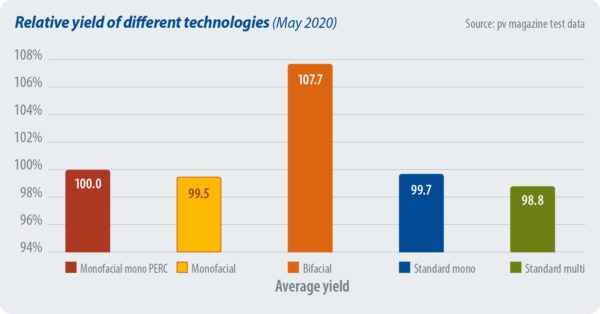The first chart to the right gives the meteo station data (irradiance and ambient temperature) for May 2020. Meteo data is missing from May 2 to May 5 due to a power cut. The monthly energy yield data for the months from February to May 2020 are given in the second table below. The second chart to the right shows the total energy yield of all products for May 2020.
A new bifacial mono PERC product (RSM114-6-405BMDG) from Risen Energy was installed on April 15. It has now been tested for an entire month and its performance will be shown in this month’s results. The average bifacial boost is 7.7% for May 2020. Bifacial boost is defined as the extra energy yield of the bifacial products, compared to the average energy yield of all the mono-facial mono PERC products. The chart to the bottom right shows the comparison between different PV module technologies for May 2020. Bifacial modules continue to perform steadily above all of the other technologies, with multi crystalline silicon PV having the lowest yield.
Notes on the yield measurements
The energy yield is given in Wh/Wp and is calculated by dividing the energy produced by the solar module by the Pmax at STC of the module. This Pmax is the maximum STC power after a process of stabilization. The results are grouped in categories, per module type. The bifacial boost depends on many parameters: the bifaciality factor, the installation geometry, the albedo of the ground, and also the sun angle and diffuse irradiance. The ground in this case is gray gravel.
George Touloupas



This content is protected by copyright and may not be reused. If you want to cooperate with us and would like to reuse some of our content, please contact: editors@pv-magazine.com.
